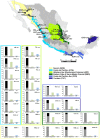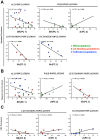Effect of biodiversity changes in disease risk: exploring disease emergence in a plant-virus system
- PMID: 22792068
- PMCID: PMC3390404
- DOI: 10.1371/journal.ppat.1002796
Effect of biodiversity changes in disease risk: exploring disease emergence in a plant-virus system
Abstract
The effect of biodiversity on the ability of parasites to infect their host and cause disease (i.e. disease risk) is a major question in pathology, which is central to understand the emergence of infectious diseases, and to develop strategies for their management. Two hypotheses, which can be considered as extremes of a continuum, relate biodiversity to disease risk: One states that biodiversity is positively correlated with disease risk (Amplification Effect), and the second predicts a negative correlation between biodiversity and disease risk (Dilution Effect). Which of them applies better to different host-parasite systems is still a source of debate, due to limited experimental or empirical data. This is especially the case for viral diseases of plants. To address this subject, we have monitored for three years the prevalence of several viruses, and virus-associated symptoms, in populations of wild pepper (chiltepin) under different levels of human management. For each population, we also measured the habitat species diversity, host plant genetic diversity and host plant density. Results indicate that disease and infection risk increased with the level of human management, which was associated with decreased species diversity and host genetic diversity, and with increased host plant density. Importantly, species diversity of the habitat was the primary predictor of disease risk for wild chiltepin populations. This changed in managed populations where host genetic diversity was the primary predictor. Host density was generally a poorer predictor of disease and infection risk. These results support the dilution effect hypothesis, and underline the relevance of different ecological factors in determining disease/infection risk in host plant populations under different levels of anthropic influence. These results are relevant for managing plant diseases and for establishing conservation policies for endangered plant species.
Conflict of interest statement
The authors have declared that no competing interests exist.
Figures


Similar articles
-
Environmental heterogeneity and the evolution of plant-virus interactions: Viruses in wild pepper populations.Virus Res. 2017 Sep 15;241:68-76. doi: 10.1016/j.virusres.2017.05.015. Epub 2017 May 26. Virus Res. 2017. PMID: 28554561 Review.
-
Human Management of a Wild Plant Modulates the Evolutionary Dynamics of a Gene Determining Recessive Resistance to Virus Infection.PLoS Genet. 2016 Aug 4;12(8):e1006214. doi: 10.1371/journal.pgen.1006214. eCollection 2016 Aug. PLoS Genet. 2016. PMID: 27490800 Free PMC article.
-
Landscape heterogeneity shapes host-parasite interactions and results in apparent plant-virus codivergence.Mol Ecol. 2013 Apr;22(8):2325-40. doi: 10.1111/mec.12232. Epub 2013 Feb 4. Mol Ecol. 2013. PMID: 23379795
-
The effect of ecosystem biodiversity on virus genetic diversity depends on virus species: A study of chiltepin-infecting begomoviruses in Mexico.Virus Evol. 2015 Jun 1;1(1):vev004. doi: 10.1093/ve/vev004. eCollection 2015. Virus Evol. 2015. PMID: 27774278 Free PMC article.
-
Ecosystem simplification, biodiversity loss and plant virus emergence.Curr Opin Virol. 2015 Feb;10:56-62. doi: 10.1016/j.coviro.2015.01.005. Epub 2015 Jan 29. Curr Opin Virol. 2015. PMID: 25638504 Free PMC article. Review.
Cited by
-
Virus Latency and the Impact on Plants.Front Microbiol. 2019 Dec 6;10:2764. doi: 10.3389/fmicb.2019.02764. eCollection 2019. Front Microbiol. 2019. PMID: 31866963 Free PMC article. Review.
-
Endemicity and prevalence of multipartite viruses under heterogeneous between-host transmission.PLoS Comput Biol. 2019 Mar 18;15(3):e1006876. doi: 10.1371/journal.pcbi.1006876. eCollection 2019 Mar. PLoS Comput Biol. 2019. PMID: 30883545 Free PMC article.
-
Disease Pandemics and Major Epidemics Arising from New Encounters between Indigenous Viruses and Introduced Crops.Viruses. 2020 Dec 4;12(12):1388. doi: 10.3390/v12121388. Viruses. 2020. PMID: 33291635 Free PMC article. Review.
-
An exploration of hypotheses that explain herbivore and pathogen attack in restored plant communities.PLoS One. 2015 Feb 20;10(2):e0116650. doi: 10.1371/journal.pone.0116650. eCollection 2015. PLoS One. 2015. PMID: 25699672 Free PMC article.
-
The Assembly of Tropical Dry Forest Tree Communities in Anthropogenic Landscapes: The Role of Chemical Defenses.Plants (Basel). 2022 Feb 14;11(4):516. doi: 10.3390/plants11040516. Plants (Basel). 2022. PMID: 35214850 Free PMC article.
References
-
- Morse SS, Schluederberg A. Emerging viruses: the evolution of viruses and viral diseases. J Infect Dis. 1990;162:1–7. - PubMed
-
- Jones RAC. Plant virus emergence and evolution: Origins, new encounter scenarios, factors driving emergence, effects of changing world conditions, and prospects for control. Virus Res. 2009;141:113–130. - PubMed
-
- Keesing F, Holt RD, Ostfeld RS. Effects of species diversity on disease risk. Ecol Lett. 2006;9:485–498. - PubMed
Publication types
MeSH terms
LinkOut - more resources
Full Text Sources

